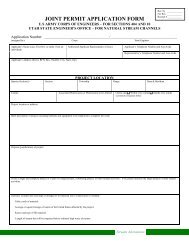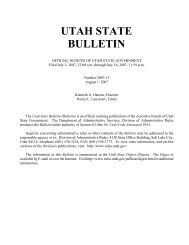Vol. 2010, No. 11 (06/01/2010) PDF - Administrative Rules - Utah.gov
Vol. 2010, No. 11 (06/01/2010) PDF - Administrative Rules - Utah.gov
Vol. 2010, No. 11 (06/01/2010) PDF - Administrative Rules - Utah.gov
Create successful ePaper yourself
Turn your PDF publications into a flip-book with our unique Google optimized e-Paper software.
NOTICES OF PROPOSED RULES DAR File <strong>No</strong>. 33621<br />
the Division in excess of $50,000; although the Division may<br />
require acceptable bid security and performance and payment bonds<br />
on smaller contracts. Bidding Documents shall state whether<br />
acceptable bid security, performance bonds or payment bonds are<br />
required.<br />
(2) Acceptable Bid Security.<br />
(a) Invitations for Bids and Requests For Proposals shall<br />
require the submission of acceptable bid security in an amount<br />
equal to at least five percent of the bid, at the time the bid is<br />
submitted. If a contractor fails to accompany its bid with acceptable<br />
bid security, the bid shall be deemed nonresponsive, unless this<br />
failure is found to be nonsubstantial as hereinafter provided.<br />
(b) If acceptable bid security is not furnished, the bid<br />
shall be rejected as nonresponsive, unless the failure to comply is<br />
determined by the Director to be nonsubstantial. Failure to submit<br />
an acceptable bid security may be deemed nonsubstantial if:<br />
(i)(A) the bid security is submitted on a form other than<br />
the Division's required bid bond form and the bid security meets all<br />
other requirements including being issued by a surety meeting the<br />
requirements of Subsection (5); and<br />
(B) the contractor provides acceptable bid security by the<br />
close of business of the next succeeding business day after the<br />
Division notified the contractor of the defective bid security; or<br />
(ii) only one bid is received.<br />
(3) Payment and Performance Bonds. Payment and<br />
performance bonds in the amount of 100% of the contract price are<br />
required for all contracts in excess of $50,000. These bonds shall<br />
cover the procuring agencies and be delivered by the contractor to<br />
the Division at the same time the contract is executed. If a<br />
contractor fails to deliver the required bonds, the contractor's bid<br />
shall be found nonresponsive and its bid security shall be forfeited.<br />
(4) Forms of Bonds. Bid Bonds, Payment Bonds and<br />
Performance Bonds must be from sureties meeting the requirements<br />
of Subsection (5) and must be on the exact bond forms most<br />
recently adopted by the Board and on file with the Division.<br />
(5) Surety firm requirements. All surety firms must be<br />
authorized to do business in the State of <strong>Utah</strong> and be listed in the<br />
U.S. Department of the Treasury Circular 570, Companies Holding<br />
Certificates of Authority as Acceptable Securities on Federal Bonds<br />
and as Acceptable Reinsuring Companies for an amount not less<br />
than the amount of the bond to be issued. A co-surety may be<br />
utilized to satisfy this requirement.<br />
(6) Waiver. The Director may waive the bonding<br />
requirement if the Director finds, in writing, that bonds cannot be<br />
reasonably obtained for the work involved.<br />
R23-1-45. Methods of Construction Contract Management.<br />
(1) Application. This section contains provisions<br />
applicable to the selection of the appropriate type of construction<br />
contract management.<br />
(2) Flexibility. The Director shall have sufficient<br />
flexibility in formulating the construction contract management<br />
method for a particular project to fulfill the needs of the procuring<br />
agencies. In each instance consideration commensurate with the<br />
project's size and importance should be given to all the appropriate<br />
and effective means of obtaining both the design and construction<br />
of the project. The methods for achieving the purposes set forth in<br />
this rule are not to be construed as an exclusive list.<br />
(3) Selecting the Method of Construction Contracting. In<br />
selecting the construction contracting method, the Director shall<br />
consider the results achieved on similar projects in the past, the<br />
methods used, and other appropriate and effective methods and how<br />
they might be adapted or combined to fulfill the needs of the<br />
procuring agencies. The use of the design-bid-build method is an<br />
appropriate contracting method for the majority of construction<br />
contracts entered into by the Division with a cost equal to or less<br />
than $1,500,000 and the construction manager/general contractor<br />
method is an appropriate contracting method for the majority of<br />
construction contracts entered into by the Division with a cost<br />
greater than $1,500,000. The Director shall include a statement in<br />
the project file setting forth the basis for using any construction<br />
contracting method other than those suggested in the preceding<br />
sentence.<br />
(4) Criteria for Selecting Construction Contracting<br />
Methods. Before choosing the construction contracting method to<br />
use, the Director shall consider the factors outlined in Subsection<br />
63G-6-5<strong>01</strong>(1)(c).<br />
(5) General Descriptions.<br />
(a) Application of Descriptions. The following<br />
descriptions are provided for the more common contracting<br />
methods. The methods described are not all mutually exclusive and<br />
may be combined on a project. These descriptions are not intended<br />
to be fixed for all construction projects of the State. In each project,<br />
these descriptions may be adapted to fit the circumstances of that<br />
project.<br />
(b) Design-Bid-Build. The design-bid-build method is<br />
typified by one business, acting as a general contractor, contracting<br />
with the state to complete a construction project in accordance with<br />
drawings and specifications provided by the state within a defined<br />
time period. Generally the drawings and specifications are prepared<br />
by an architectural or engineering firm under contract with the state.<br />
Further, while the general contractor may take responsibility for<br />
successful completion of the project, much of the work may be<br />
performed by specialty contractors with whom the prime contractor<br />
has entered into subcontracts.<br />
(c) Design-Build. In a design-build project, a business<br />
contracts directly with the Division to meet requirements described<br />
in a set of performance specifications. The design-build contractor<br />
is responsible for both design and construction. This method can<br />
include instances where the design-build contractor supplies the site<br />
as part of the package.<br />
(d) Construction Manager/General Contractor. A<br />
construction manager/general contractor is a firm experienced in<br />
construction that provides professional services to evaluate and to<br />
implement drawings and specifications as they affect time, cost, and<br />
quality of construction and the ability to coordinate the construction<br />
of the project, including the administration of change orders. The<br />
Division may contract with the construction manager/general<br />
contractor early in a project to assist in the development of a cost<br />
effective design. The construction manager/general contractor will<br />
generally become the general contractor for the project and procure<br />
subcontract work at a later date. The procurement of a construction<br />
manager/general contractor may be based, among other criteria, on<br />
proposals for a management fee which is either a lump sum or a<br />
percentage of construction costs with a guaranteed maximum cost.<br />
If the design is sufficiently developed prior to the selection of a<br />
construction manager/general contractor, the procurement may be<br />
14 UTAH STATE BULLETIN, June <strong>01</strong>, <strong>2<strong>01</strong>0</strong>, <strong>Vol</strong>. <strong>2<strong>01</strong>0</strong>, <strong>No</strong>. <strong>11</strong>


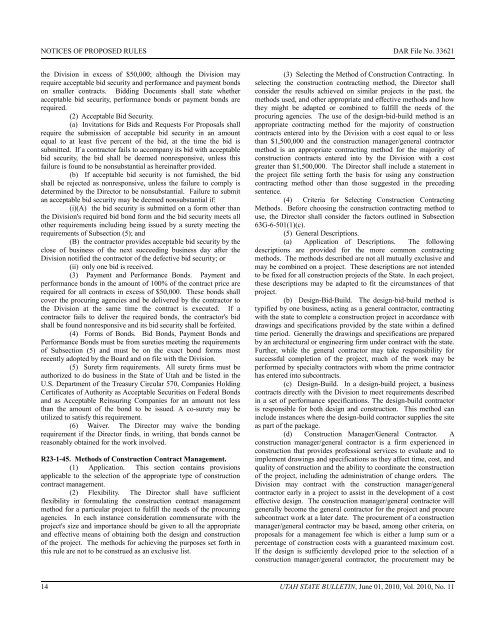
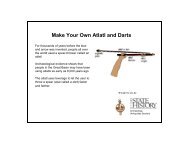

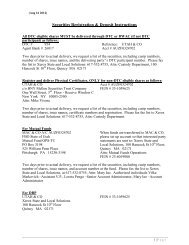
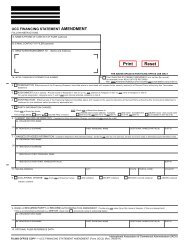
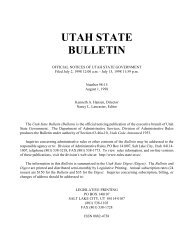
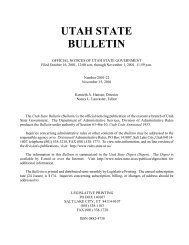



![Lynx avoidance [PDF] - Wisconsin Department of Natural Resources](https://img.yumpu.com/41279089/1/159x260/lynx-avoidance-pdf-wisconsin-department-of-natural-resources.jpg?quality=85)


